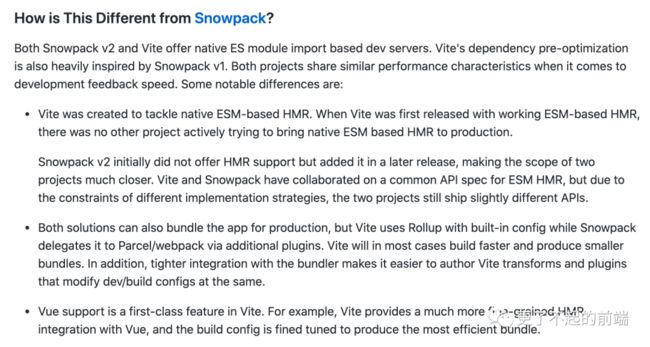面向未来的前端构建工具-vite
前言
如果近期你有关注 Vue 的动态,就能发现 Vue 作者最近一直在捣鼓的新工具 vite。vite 1.0 目前已经进入了 rc 版本,马上就要正式发布 1.0 的版本了。几个月前,尤雨溪就已经在微博介绍过了 vite ,是一个基于浏览器原生 ESM 的开发服务器。
 尤雨溪微博
尤雨溪微博
早期 Webpack 刚出来的时候,是为了解决低版本浏览器不支持 ESM 模块化的问题,将各个分散的 JavaScript 模块合并成一个文件,同时将多个 JavaScript 脚本文件合并成一个文件,减少 HTTP 请求的数量,有助于提升页面首次访问的速度。后期 Webpack 乘胜追击,引入了 Loader、Plugin 机制,提供了各种构建相关的能力(babel转义、css合并、代码压缩),取代了同期的 Browserify、Gulp。
如今,HTTP/2 的盛行,HTTP/3 也即将发行,再加上 5G 网络的商用,减少 HTTP 请求数量起到的作用已经微乎其微,而且新版的浏览器基本已经支持了 ESM(
所有的 js 文件经过 vite 处理后,其 import 的模块路径都会被修改,在前面加上 /@modules/。当浏览器请求 import 模块的时候,vite 会在 node_modules 中找到对应的文件进行返回。
import { createApp } from 'vue'
import App from './App.vue'
import './index.css'
createApp(App).mount('#app')
 请求
请求
这样就省略了打包的过程,大大提升了开发效率。当然 vite 也提供了生产模式,利用 Rollup 进行构建。
谈谈 snowpack
首次提出利用浏览器原生 ESM 能力的工具并非是 vite,而是一个叫做 snowpack 的工具。snowpack 在发布 1.0 之前,名字还叫做 @pika/web。
 snowpack rename
snowpack rename
pika 团队之所以要做 snowpack ,是因为 pika 致力于为 web 应用提速 90%。
 pika
pika
由于当前许多 web 应用都是在不同开源模块的基础上进行构建的,而这些开源模块都被 webpack 之类的打包工具打成了一个包,如果这些开源模块都来源于同一个 CDN 地址,且支持跨域缓存,那么这些开源模块都只需要加载一次,其他网站用到了同样的开源模块,就不需要重新在下载,直接读取本地缓存。
举个例子,淘宝和天猫都是基于 react + redux + antd + loadsh 进行开发的,当我打开过淘宝之后,进入天猫这些开源模块都不用重新下载,只需要下载天猫页面相关的一些业务代码即可。为此,pika 专门建立了一个 CDN(skypack) 用了下载 npm 上的一些 esm 模块。
后来 snowpack 发布的时候,pika 团队顺便发表了一篇名为《A Future Without Webpack》 的文章,告诉大家可以尝试抛弃 webpack,革 webpack 的命。
 snowpack
snowpack
在 vite 的 README 中也提到了在某些方面参考了 snowpack,并且列举了 vite 与 snowpack 的异同。
 Different
Different
snowpack 现在已经发布到 v2 了,我们可以找到 v1 时期的源码看看 snowpack 的早期实现。
源码解析
在 github 上,根据 git tag 可以找到 snowpack v1.0.0 的版本,下载下来发现好像有点 bug ,建议大家阅读源码的时候可以跳到 v1.2.0(https://github.com/pikapkg/snowpack/tree/v1.2.0)。
在 package.json 中可以看到,snowpack 通过他们团队的 @pika/pack 进行打包,这个工具将打包流程进行了管道化,有点类似与 gulp,感兴趣可以了解了解,这里重点还是 snowpack 的原理。
{
"scripts": {
"build": "pika build"
},
// snowpack 的构建工具
"@pika/pack": {
"pipeline": [
[
"@pika/plugin-ts-standard-pkg"
],
[
"@pika/plugin-copy-assets"
],
[
"@pika/plugin-build-node"
],
[
"@pika/plugin-simple-bin",
{
// 通过 snowpack 运行命令
"bin": "snowpack"
}
]
]
}
}
这里我们以 vue 项目为例,使用 snowpack 运行一个 vue 2 的项目。目录结构如下:
 目录结构
目录结构
如果要在项目中引入 snowpack,需要在项目的 package.json 中,添加 snowpack 相关的配置,配置中比较重要的就是这个 snowpack.webDependencies,表示当前项目的依赖项,这两个文件会被 snowpack 打包到 web_modules 目录。
{
"scripts": {
"build": "snowpack",
"start": "serve ./"
},
"dependencies": {
"http-vue-loader": "^1.4.2",
"vue": "^2.6.12"
},
"devDependencies": {
"serve": "^11.3.2",
"snowpack": "~1.2.0"
},
"snowpack": {
"webDependencies": [
"http-vue-loader",
"vue/dist/vue.esm.browser.js"
]
}
}
运行 npm run build 之后,会新生成一个 web_modules 目录,该目录下的文件就是我们在 snowpack.webDependencies 中声明的两个 js 文件。
 npm run build
npm run build
 web_modules
web_modules
snowpack 运行的时候,会调用源码 src/index.ts 中的 cli 方法,该方法的代码删减版如下:
// 精简了部分代码,如果想看完整版建议去 github
// https://github.com/pikapkg/snowpack/blob/v1.2.0/src/index.ts
const cwd = process.cwd();
export async function cli(args: string[]) {
// 解析命令行参数
const { dest = 'web_modules' } = yargs(args);
// esm 脚本文件的输出目录,默认为 web_modules
const destLoc = path.resolve(cwd, dest);
// 获取 pkg.json
const pkgManifest: any = require(path.join(cwd, 'package.json'));
// 获取 pkg.json 中的依赖模块
const implicitDependencies = [
...Object.keys(pkgManifest.dependencies || {}),
...Object.keys(pkgManifest.peerDependencies || {}),
];
// 获取 pkg.json 中 snowpack 相关配置
const { webDependencies } = pkgManifest['snowpack'] || {
webDependencies: undefined
};
const installTargets = [];
// 需要被安装的模块,如果没有该配置,会尝试安装所有 dependencies 内的模块
if (webDependencies) {
installTargets.push(...scanDepList(webDependencies, cwd));
} else {
installTargets.push(...scanDepList(implicitDependencies, cwd));
}
// 模块安装
const result = await install(installTargets, installOptions);
}
该方法会读取项目的 package.json 文件,如果有 snowpack.webDependencies 配置,会优先安装 snowpack.webDependencies 中声明的模块,如果没有该配置,会把 dependencies 和 devDependencies 中的模块都进行安装。所有的模块名都会通过 scanDepList,转化为特定格式,并且会把glob语法的模块名,经过 glob 还原成单个的文件。
import path from 'path';
function createInstallTarget(specifier: string): InstallTarget {
return {
specifier,
named: [],
};
}
export function scanDepList(depList: string[], cwd: string): InstallTarget[] {
// 获取 node_modules 路径
const nodeModules = path.join(cwd, 'node_modules');
return depList
.map(whitelistItem => {
// 判断文件名是否为 glob 语法 (e.g. `vue/*.js`)
if (!glob.hasMagic(whitelistItem)) {
return [createInstallTarget(whitelistItem)];
} else {
// 转换 glob 路径
return scanDepList(glob.sync(whitelistItem,{cwd: nodeModules}), cwd);
}
})
// 将所有文件合并成一个数组
.reduce((flat, item) => flat.concat(item), []);
}
最后,所有的模块会经过 install 进行安装。
 install
install
// 移除 .js、.mjs 后缀
function getWebDependencyName(dep: string): string {
return dep.replace(/\.m?js$/i, '');
}
// 获取模块的类型以及绝对路径
function resolveWebDependency(dep: string): {
type: 'JS' | 'ASSET';
loc: string;
} {
var packagePattern = new RegExp('^(?:@([^/]+?)[/])?([^/]+?)$')
// 如果带有扩展名,且非 npm 模块,直接返回
if (path.extname(dep) && !packagePattern.test(dep)) {
const isJSFile = ['.js', '.mjs', '.cjs'].includes(path.extname(dep));
return {
type: isJSFile ? 'JS' : 'ASSET',
// 还原绝对路径
loc: require.resolve(dep, {paths: [cwd]}),
};
}
// 如果是 npm 模块,需要查找模块对应的 package.json 文件
const manifestPath = `${cwd}/node_modules/${dep}/package.json`;
const manifestStr = fs.readFileSync(manifestPath, {encoding: 'utf8'});
const depManifest = JSON.parse(manifestStr);
// 然后读取 package.json 中的 module属性、browser属性
let foundEntrypoint: string =
depManifest['browser:module'] || depManifest.module || depManifest.browser;
if (!foundEntrypoint) {
// 如果都不存在就取 main 属性
foundEntrypoint = depManifest.main || 'index.js';
}
return {
type: 'JS',
// 还原绝对路径
loc: path.join(`${cwd}/node_modules/${dep}`, foundEntrypoint),
};
}
// 模块安装
function install(installTargets, installOptions) {
const {
destLoc
} = installOptions;
// 使用 set 将待安装模块进行一次去重
const allInstallSpecifiers = new Set(installTargets.map(dep => dep.specifier));
// 模块查找转化
for (const installSpecifier of allInstallSpecifiers) {
// 移除 .js、.mjs 后缀
const targetName = getWebDependencyName(installSpecifier);
// 获取文件类型,以及文件绝对路径
const {type: targetType, loc: targetLoc} = resolveWebDependency(installSpecifier);
if (targetType === 'JS') {
// 脚本文件
const hash = await generateHashFromFile(targetLoc);
// 添加到脚本依赖对象
depObject[targetName] = targetLoc;
importMap[targetName] = `./${targetName}.js?rev=${hash}`;
installResults.push([installSpecifier, true]);
} else if (targetType === 'ASSET') {
// 静态资源
// 添加到静态资源对象
assetObject[targetName] = targetLoc;
installResults.push([installSpecifier, true]);
}
}
if (Object.keys(depObject).length > 0) {
// 通过 rollup 打包文件
const packageBundle = await rollup.rollup({
input: depObject,
plugins: [
// rollup 插件
// 这里可以进行一些 babel 转义、代码压缩之类的操作
// 还可以将一些 commonjs 的模块转化为 ESM 模块
]
});
// 文件输出到 web_modules 目录
await packageBundle.write({
dir: destLoc,
});
}
// 拷贝静态资源
Object.entries(assetObject).forEach(([assetName, assetLoc]) => {
mkdirp.sync(path.dirname(`${destLoc}/${assetName}`));
fs.copyFileSync(assetLoc, `${destLoc}/${assetName}`);
});
return true;
}
基本原理已经分析完毕,下面看一看实际案例。我们在 html 中通过 type="module" 的 script 标签引入 index.js 作为入口文件。
snowpack-vue-httpvueloader
snowpack - Vue Example